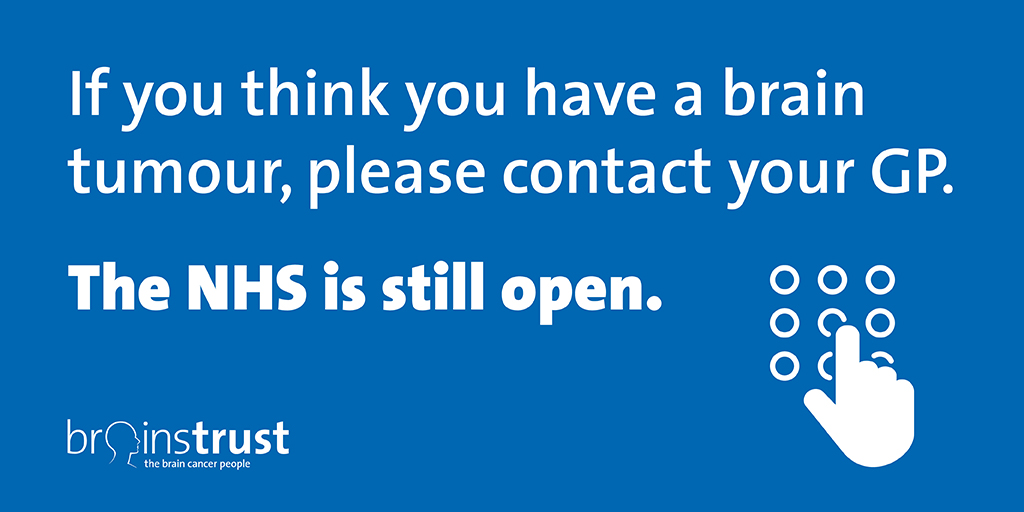If you think you have a brain tumour, or are worried about cancer, please contact your GP. The NHS is still open.

The NHS is very much open for people with cancer, or suspected cancer. GPs (primary care) and hospitals (secondary care) are concerned that they are seeing fewer people with signs of cancer. This includes people with brain tumour symptoms. We know that neurosurgical departments are seeing fewer cases at a number of hospitals, and also that the number of people being referred to hospitals through the two-week wait (2WW) referral system has dropped by 75%. This is for all cancers. As ever, being diagnosed with a brain tumour is a little different with nearly 60% of people being diagnosed through accident and emergency.
What is the impact?
Two large hospitals have reported to brainstrust a very worrying drop in people having neurosurgery for the most aggressive brain tumour, a glioblastoma (GBM). One major centre that usually has 3 to 4 GBMs every week discussed at MDT – there have been none in the last three weeks. Another neuroscience centre usually has 6 GBM surgeries every week. It has had one in the last 2 weeks and none booked for the foreseeable future. These cases are being referred straight to palliative care and are having no active treatment.
So – if you are worried and think you may have a brain tumour, your GP is your first port of call, or A&E if you feel your symptoms need urgent attention – such as if you have had a seizure for the first time, or you have signs or symptoms like those associated with a stroke.
Helen Bulbeck, brainstrust’s Director of Services, is working closely hospitals in understanding the impact of COVID-19 on people with a brain tumour. She says: “It is vital that people are diagnosed promptly if they have cancer, including a brain tumour. And we all have a part to play in getting diagnostic services switched on again too. If you have signs or symptoms that are associated with a brain tumour then we’d urge you to seek medical advice, either from your GP or A&E if you require urgent help for severe signs”.
During Wednesday’s briefing from NHS England on cancer care in the context of COVID-19 we highlighted the challenge: “There is urgent need for stronger messaging that the NHS is still open. We are concerned that [in some hospitals] the most aggressive brain cancer (glioblastoma – GBM) cases have evaporated. We know of one hospital that would usually have 3 to 4 GBMs every week discussed at MDT – there have been none in the last three weeks. And another that usually has 6 GBM surgeries every week. They have had one in the last 2 weeks and none booked for the foreseeable future. These cases are being referred straight to palliative care and are having no active treatment. On average this shortens these people’s lives by a year.”
NHS England’s Clinical Director for Cancer responded that he would look into this straight away. And on Wednesday, Secretary of State for Health, Matt Hancock said in response to a question from Labour MP Rosie Cooper, that whilst he can’t give a guarantee that all cancer treatment will go ahead, that there is enough capacity in the NHS for cancer patients. He added that while “the virus is still at large” there is some cancer treatment that is “clinically inadvisable to undertake now”. “Having said that, we do want people to come forward – we want as much cancer treatment going ahead as possible,” he adds.
But we must remember that we all have a role to play too. If you suspect you have a brain tumour, if you have a brain tumour and you’re feeling things are worse than they have been previously, or if you suspect cancer at all, you should speak to a doctor.
Signs and symptoms
We have compiled a list of brain tumour symptoms on our website, but please bear in mind that we cannot advise whether or not you have a brain tumour – only a doctor can do that. Our support is available once you have received a diagnosis.
You can read about the red flags for a brain tumour here.
And don’t forget, if you are unwell, your doctor wants to help you.










